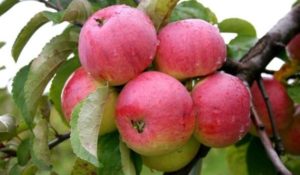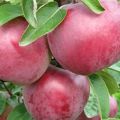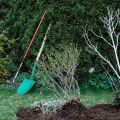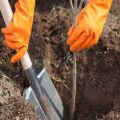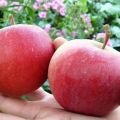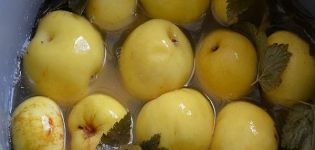Description and characteristics of the columnar apple variety Vasyugan, planting and care
Due to its peculiar external characteristics, early maturity and high yield, the columnar apple of the Vasyugan variety is in great demand among amateur gardeners. This variety is unpretentious to care for, has good taste and decorative properties. In order for the apple tree to give a crop every year, it is necessary to follow all the rules of agricultural work and provide the tree with the necessary care.
Benefits of the columnar Vasyugan apple tree
The advantages of the Vasyugan apple tree include:
- good presentation and high taste;
- compactness and decorative properties;
- abundance and early periods of fruiting;
- winter hardiness;
- lack of a spreading crown;
- affordable care;
- crop stability;
- disease resistance.
External parameters
When replenishing the garden with new specimens of fruit trees, first of all, it is worth familiarizing yourself with the characteristics and description of the culture.
Barrel height
The Vasyugan apple tree has a single trunk (column), the height of which depends on the stock and does not exceed 2.5 meters. The trunk is strong, thickened, covered with fruit shoots (ringlets).
Crown diameter
Despite the power of the trunk, the crown of the tree is very compact and has a vertical arrangement. Due to genetic characteristics, side shoots are practically absent, few branches are formed parallel to the trunk. The crown width is about 0.5 meters.
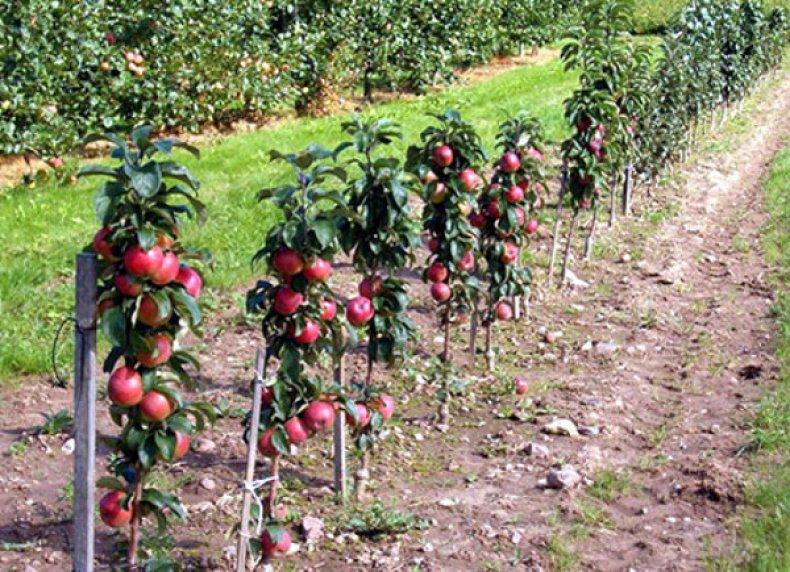
Root system
The superficial root system of the Vasyugan apple tree is fibrous, resistant to various diseases. Shallow roots in the ground require regular and thorough watering.
Leaves and flowers
The foliage of the Vasyugan variety is dense, large, dark green in color. It has an elongated shape with small notches at the tip. Flowers are large, white and pink.
Fruit and its taste
Apples grow elongated and conical in shape with a rather thin peel of a red-striped hue. The pulp is juicy, with a pleasant dessert taste. The size of the fruits reaches medium-large sizes, and the weight of one apple is about 150 g.The shelf life of fruits does not exceed one month.

Characteristics of the variety
The medium-sized Vasyugan apple variety was bred artificially - by grafting an ordinary variety onto a super-dwarf clonal stock with subsequent formative pruning.
Winter hardiness
The genotypic feature of the Vasyugan variety is its ability to withstand frosts, sudden temperature changes and spring night frosts, which allows the tree to survive in a harsh climate.
Susceptibility to diseases and pests
The predisposition of the Vasyugan apple tree to diseases is less pronounced than that of other varieties. However, pest attacks, various infections, natural disasters or improper care pose the risk of various diseases.
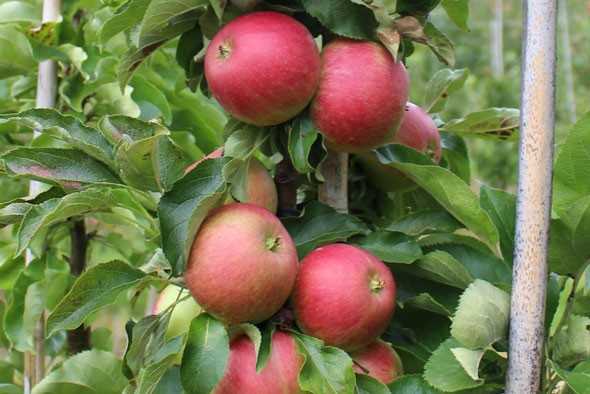
Yield
A full harvest can be expected for 5 years, on average, up to 6-8 kg per tree. Under favorable conditions, the yield of the apple tree annually increases to high rates, from one tree it is possible to collect up to 12-15 kg of high-quality fruits.
Life span
The period of effective fruiting in the Vasyugan apple tree lasts about 12 years, and then the productivity gradually decreases.
Features of fruiting culture
In the apple tree, fruit development occurs on the ringlets, which abundantly cover the column. As soon as the tree begins to bear fruit, its growth is inhibited, and in subsequent years all its forces are concentrated on fruiting, thereby ensuring regular fruiting.
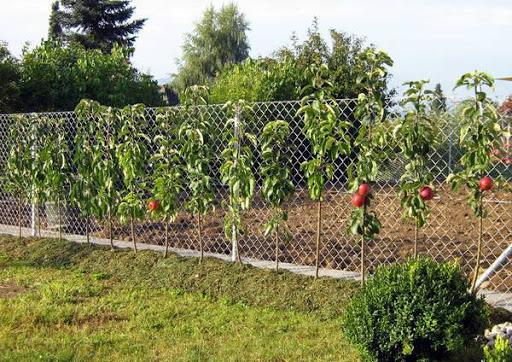
What year after planting it bears fruit
The tree is capable of bearing fruit in the second year after planting. It will be possible to harvest several apples from each tree, however, in order to prevent depletion of nutrients, it is recommended to remove the inflorescences.
Flowering period
The apple tree begins to bloom in early May. At this time, the tree is abundantly covered with large fragrant inflorescences.
Ripening dates and harvesting
Mass ripening of apples occurs in August or early September. Depending on the location and weather conditions, the period of full maturity can be shifted to both July and the second half of September.
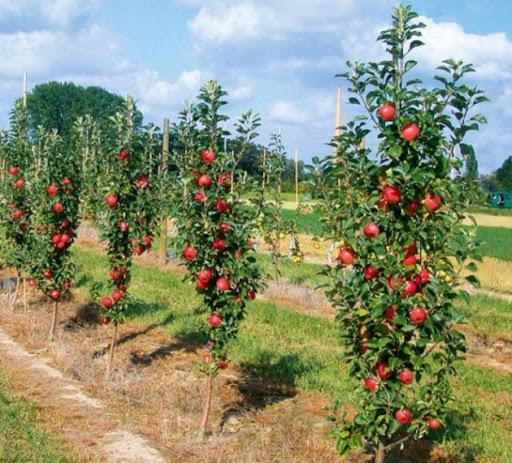
How planting and grooming should be done
Planting activities require serious organization. For this, the site, the planting pit and the seedling itself are being prepared.
Growing area
The Vasyugan variety is intended for cultivation in the Far East and the Urals. Due to its high winter hardiness, the apple tree is no less common in Siberia, the Urals and the Trans-Urals.
Planting season
Early spring is the best time to plant trees. In the southern regions, the Vasyugan apple tree is planted in September or in the first half of October. So the tree will have time to take root before the frost and prepare for the upcoming winter.

Preparation of seedlings and planting pit
When choosing seedlings, you need to pay attention to the condition of the bark and roots. If there are growths, dark spots or any damage, it is better to refuse to buy such a seedling.
Before planting, to select a site, an inspection of the site is carried out, during which the distance between trees (40-50 cm) and row spacing (1 m) must be taken into account. The location should be chosen in a well-lit and draft-free area. Chernozem, sandy loam or loam are ideal as soil for an apple tree.
Before planting annual seedlings, follow these steps:
- Saturate the open roots of the seedling with plenty of water.
- Soak the roots for 2 hours in a clay mash.
- Cut the roots by 4-5 cm.
- Dig a planting hole 50x70 cm in size, the depth of the hole depends on the length of the root, about 0.5-0.7 cm.
- Fill the hole with a drainage layer, potting soil and fertilizer.
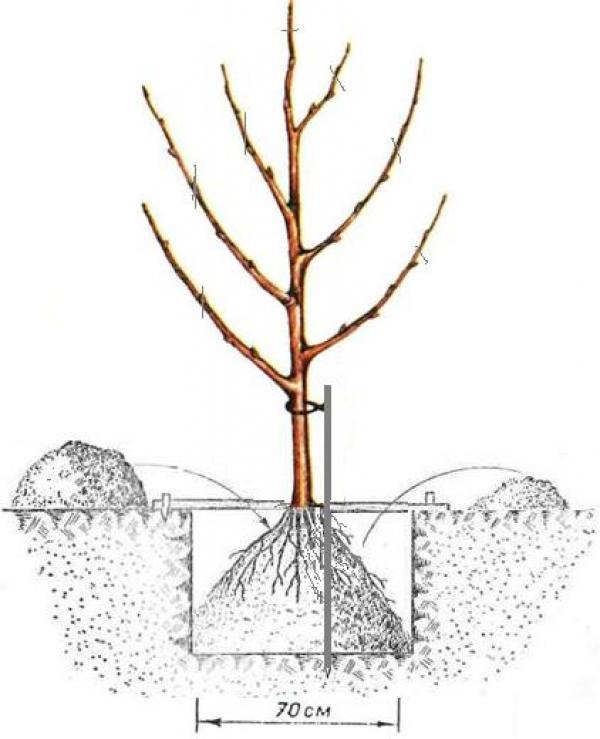
After the ground in the hole sits down, you can start planting a seedling.
Landing technology
Install a peg in the side of the pit for support.Place the seedling directly in the center of the pit, while the root collar should be located above the level of the plot. Spread the roots, sprinkle with soil, compact and tie them to the support for reliability. Then draw up a trunk circle and pour 10-20 liters of water. After absorbing water, mulch the soil.
Regularity of watering
The first watering is carried out a week after planting the seedling, with a large supply of water (30 l). It is recommended to water young seedlings rarely, but abundantly (10-20 l). Excessive moisture or stagnant water in the root pit can lead to root rot. During active growth, the apple tree is watered at least 3 times a week. In rainy weather, the amount of watering is reduced to a minimum.
Mature trees are watered 1-2 times a week. From the end of June, watering is gradually reduced, and by mid-August it is finally stopped, since the trees must have time to complete the formation of flower buds and prepare for wintering.

Seasonal prevention
In order to protect trees from temperature extremes, diseases, pests, as well as to prepare the garden for winter, preventive work is carried out:
- trimming;
- feeding and treatment with fungicides;
- whitewashing carried out seasonally 2-3 times a year;
- foliage cleaning;
- removal of weeds and carrion;
- mulching of near-trunk circles.
When and how to feed a young and adult tree
Foliar feeding of the tree is performed seasonally, 3 times a year. Leaf feeding is carried out during the growing season, using urea (15 g per 10 l). Root feeding is carried out once a year, for this purpose, ammonium nitrate is used (35 g per tree).

In spring, for young trees, an infusion of liquid bird droppings diluted 1: 8 will be a good top dressing. Humus is used as a surface fertilizer, which is scattered before digging. In summer and autumn, the best feeding is a solution (1: 3) of mullein and nitrophoska (50 g: 10 l of water). Fertilizing increases yields and protects the crop from disease.
Formation of the correct crown
A year later, when the tree is formed into a column, the lateral processes are removed, leaving 2 buds. The next year, two shoots form on the buds left. One that grows horizontally is left, and the other is shortened by 2 buds. The crown is cut off only if it is damaged.
In addition to shaping, trees need sanitary pruning, which consists in removing dry and diseased branches on the crown. It is carried out once a year before the start of sap flow.
Do I need to cover the tree for winter
The superficial location of the roots can threaten the culture with freezing, so the gardener must take care of frost protection measures. For this, the branches of the tree are tied, and the lower part of the trunk and the top are insulated.
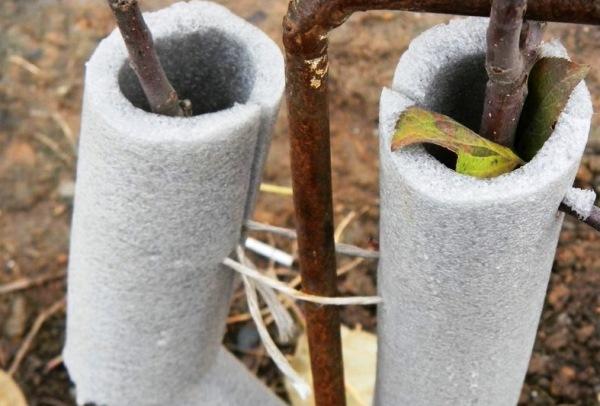
Varieties
Depending on the scion, these apple trees are divided into species: superdwarfs, dwarfs, semi-dwarfs, medium-sized, vigorous.
Dwarf
Apple trees of this species are obtained by grafting clonal grafts with the Co gene onto dwarf rootstocks. The tree is particularly fragile, slow growing and has a unique ability to form fruits throughout the trunk from the first year. Possesses moderate winter hardiness and disease resistance.
This group includes the most popular varieties: Dialogue, Arbat, Currency.
Early
The variety of varieties differs not only in the height of the tree, but also in terms of ripening. The technical ripeness of summer apples begins from mid-July to the first half of August. The shelf life of such fruits is short, no more than 4 weeks. The most common varieties are: Medoc, President.
